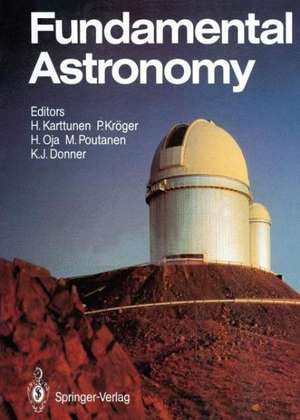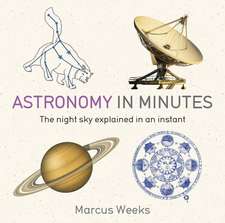Fundamental Astronomy: Springer Study Edition
Editat de Hannu Karttunen, Pekka Kröger, Heikki Oja, Markku Putanen, Karl J. Donneren Limba Engleză Paperback – 18 apr 1991
Din seria Springer Study Edition
-
 Preț: 386.26 lei
Preț: 386.26 lei -
 Preț: 370.79 lei
Preț: 370.79 lei -
 Preț: 296.06 lei
Preț: 296.06 lei -
 Preț: 403.37 lei
Preț: 403.37 lei -
 Preț: 508.91 lei
Preț: 508.91 lei - 23%
 Preț: 921.30 lei
Preț: 921.30 lei -
 Preț: 403.37 lei
Preț: 403.37 lei -
 Preț: 389.70 lei
Preț: 389.70 lei - 15%
 Preț: 502.73 lei
Preț: 502.73 lei -
 Preț: 389.70 lei
Preț: 389.70 lei - 5%
 Preț: 1122.94 lei
Preț: 1122.94 lei - 5%
 Preț: 370.38 lei
Preț: 370.38 lei -
 Preț: 406.25 lei
Preț: 406.25 lei - 15%
 Preț: 530.58 lei
Preț: 530.58 lei -
 Preț: 398.35 lei
Preț: 398.35 lei - 5%
 Preț: 368.73 lei
Preț: 368.73 lei - 15%
 Preț: 633.02 lei
Preț: 633.02 lei -
 Preț: 392.75 lei
Preț: 392.75 lei - 15%
 Preț: 588.69 lei
Preț: 588.69 lei - 20%
 Preț: 660.99 lei
Preț: 660.99 lei - 20%
 Preț: 663.61 lei
Preț: 663.61 lei - 15%
 Preț: 640.88 lei
Preț: 640.88 lei - 15%
 Preț: 654.43 lei
Preț: 654.43 lei -
 Preț: 390.46 lei
Preț: 390.46 lei - 15%
 Preț: 652.81 lei
Preț: 652.81 lei -
 Preț: 394.87 lei
Preț: 394.87 lei - 15%
 Preț: 642.03 lei
Preț: 642.03 lei - 15%
 Preț: 688.99 lei
Preț: 688.99 lei - 15%
 Preț: 642.36 lei
Preț: 642.36 lei - 15%
 Preț: 635.15 lei
Preț: 635.15 lei -
 Preț: 396.62 lei
Preț: 396.62 lei - 18%
 Preț: 893.21 lei
Preț: 893.21 lei -
 Preț: 423.34 lei
Preț: 423.34 lei - 20%
 Preț: 377.27 lei
Preț: 377.27 lei - 18%
 Preț: 742.97 lei
Preț: 742.97 lei - 15%
 Preț: 655.27 lei
Preț: 655.27 lei - 20%
 Preț: 336.02 lei
Preț: 336.02 lei -
 Preț: 397.38 lei
Preț: 397.38 lei
Preț: 419.14 lei
Nou
Puncte Express: 629
Preț estimativ în valută:
80.21€ • 87.10$ • 67.38£
80.21€ • 87.10$ • 67.38£
Carte tipărită la comandă
Livrare economică 22 aprilie-06 mai
Preluare comenzi: 021 569.72.76
Specificații
ISBN-13: 9780387975672
ISBN-10: 0387975675
Pagini: 478
Ilustrații: XIII, 478 p.
Dimensiuni: 210 x 280 x 26 mm
Greutate: 1.15 kg
Ediția:1987
Editura: Springer
Colecția Springer
Seria Springer Study Edition
Locul publicării:New York, NY, United States
ISBN-10: 0387975675
Pagini: 478
Ilustrații: XIII, 478 p.
Dimensiuni: 210 x 280 x 26 mm
Greutate: 1.15 kg
Ediția:1987
Editura: Springer
Colecția Springer
Seria Springer Study Edition
Locul publicării:New York, NY, United States
Public țintă
ResearchCuprins
1. Introduction.- 1.1 The Role of Astronomy.- 1.2 Astronomical Objects of Research.- 1.3 The Scale of the Universe.- 2. Spherical Astronomy.- 2.1 Spherical Trigonometry.- 2.2 The Earth.- 2.3 The Celestial Sphere.- 2.4 The Horizontal System.- 2.5 The Equatorial System.- 2.6 The Ecliptic System.- 2.7 The Galactic Coordinates.- 2.8 Perturbations of Coordinates.- 2.9 Constellations.- 2.10 Star Catalogues and Maps.- 2.11 Positional Astronomy.- 2.12 Time Reckoning.- 2.13 Astronomical Time Systems.- 2.14 Calendars.- 2.15 Exercises.- 3. Observations and Instruments.- 3.1 Observing Through the Atmosphere.- 3.2 Optical Telescopes.- 3.3 Detectors.- 3.4 Radio Telescopes.- 3.5 Other Wavelength Regions.- 3.6 Instruments of the Future.- 3.7 Other Forms of Energy.- 3.8 Exercises.- 4. Photometric Concepts and Magnitudes.- 4.1 Intensity, Flux Density and Luminosity.- 4.2 Apparent Magnitudes.- 4.3 Magnitude Systems.- 4.4 Absolute Magnitudes.- 4.5 Extinction and Optical Thickness.- 4.6 Exercises.- 5. Radiation Mechanisms.- 5.1 Radiation of Atoms and Molecules.- 5.2 The Hydrogen Atom.- 5.3 Quantum Numbers, Selection Rules, Population Numbers.- 5.4 Molecular Spectra.- 5.5 Continuous Spectra.- 5.6 Blackbody Radiation.- 5.7 Other Radiation Mechanisms.- 5.8 Radiative Transfer.- 5.9 Exercises.- 6. Temperatures.- 6.1 Exercises.- 7. Celestial Mechanics.- 7.1 Equations of Motion.- 7.2 Solution of the Equation of Motion.- 7.3 Equation of the Orbit and Kepler’s First Law.- 7.4 Orbital Elements.- 7.5 Kepler’s Second and Third Law.- 7.6 Orbit Determination.- 7.7 Position in the Orbit.- 7.8 Escape Velocity.- 7.9 Virial Theorem.- 7.10 The Jeans Limit.- 7.11 Exercises.- 8. The Solar System.- 8.1 An Overview.- 8.2 Planetary Configurations.- 8.3 Orbit of the Earth.- 8.4 Orbit of the Moon.- 8.5 Eclipsesand Occultations.- 8.6 Albedos.- 8.7 Planetary Photometry, Polarimetry and Spectroscopy.- 8.8 Thermal Radiation of the Planets.- 8.9 The Structure of Planets.- 8.10 Planetary Surfaces.- 8.11 Atmospheres and Magnetospheres.- 8.12 Mercury.- 8.13 Venus.- 8.14 The Earth and the Moon.- 8.15 Mars.- 8.16 Asteroids.- 8.17 Jupiter.- 8.18 Saturn.- 8.19 Uranus, Neptune and Pluto.- 8.20 Minor Bodies of the Solar System.- 8.21 Cosmogony.- 8.22 Other Solar Systems.- 8.23 Exercises.- 9. Stellar Spectra.- 9.1 Measuring Spectra.- 9.2 The Harvard Spectral Classification.- 9.3 The Yerkes Spectral Classification.- 9.4 Peculiar Spectra.- 9.5 The Hertzsprung-Russell Diagram.- 9.6 Model Atmospheres.- 9.7 What Do the Observations Tell Us.- 10. Binary Stars and Stellar Masses.- 10.1 Visual Binaries.- 10.2 Astrometric Binary Stars.- 10.3 Spectroscopic Binaries.- 10.4 Photometric Binary Stars.- 10.5 Exercises.- 11. Stellar Structure.- 11.1 Internal Equilibrium Conditions.- 11.2 Physical State of the Gas.- 11.3 Stellar Energy Sources.- 11.4 Stellar Models.- 11.5 Exercises.- 12. Stellar Evolution.- 12.1 Evolutionary Time Scales.- 12.2 The Contraction of Stars Towards the Main Sequence.- 12.3 The Main Sequence Phase.- 12.4 The Giant Phase.- 12.5 The Final Stages of Evolution.- 12.6 The Evolution of Close Binary Stars.- 12.7 Comparison with Observations.- 12.8 The Origin of the Elements.- 13. The Sun.- 13.1 Internal Structure.- 13.2 The Atmosphere.- 13.3 Solar Activity.- 14. Variable Stars.- 14.1 Classification.- 14.2 Pulsating Variables.- 14.3 Eruptive Variables.- 14.4 Exercises.- 15. Compact Stars.- 15.1 White Dwarfs.- 15.2 Neutron Stars.- 15.3 Black Holes.- 16. The Interstellar Medium.- 16.1 Interstellar Dust.- 16.2 Interstellar Gas.- 16.3 Interstellar Molecules.- 16.4 The Formation of Protostars.- 16.5 Planetary Nebulae.- 16.6 Supernova Remnants.- 16.7 The Hot Corona of the Milky Way.- 16.8 Cosmic Rays and the Interstellar Magnetic Field.- 17. Star Clusters and Associations.- 17.1 Associations.- 17.2 Open Star Clusters.- 17.3 Globular Star Clusters.- 18. The Milky Way.- 18.1 Methods of Distance Measurement.- 18.2 Stellar Statistics.- 18.3 The Rotation of the Milky Way.- 18.4 The Structure and Evolution of the Milky Way.- 18.5 Exercises.- 19. Galaxies.- 19.1 The Classification of Galaxies.- 19.2 Elliptical Galaxies.- 19.3 Spiral Galaxies.- 19.4 Lenticular Galaxies.- 19.5 Luminosities of Galaxies.- 19.6 Masses of Galaxies.- 19.7 Systems of Galaxies.- 19.8 Distances of Galaxies.- 19.9 Active Galaxies and Quasars.- 19.10 The Origin and Evolution of Galaxies.- 20. Cosmology.- 20.1 Cosmological Observations.- 20.2 The Cosmological Principle.- 20.3 Homogeneous and Isotropic Universes.- 20.4 The Friedmann Models.- 20.5 Cosmological Tests.- 20.6 History of the Universe.- 20.7 The Future of the Universe.- Appendices.- A. Mathematics.- A.1 Geometry.- A.2 Taylor Series.- A.3 Vector Calculus.- A.4 Conic Sections.- A.5 Multiple Integrals.- A.6 Numerical Solution of an Equation.- B. Quantum Mechanics.- B.1 Quantum Mechanical Model of Atoms. Quantum Numbers.- B.2 Selection Rules and Transition Probabilities.- B.3 Heisenberg’ Uncertainty Principle.- B.4 Exclusion Principle.- C. Theory of Relativity.- C.1 Basic Concepts.- C.2 Lorentz Transformation. Minkowski Space.- C.3 General Relativity.- C.4 Tests of General Relativity.- D. Radio Astronomy Fundamentals.- D.1 Antenna Definitions.- D.2 Antenna Temperature and Flux Density.- E. Tables.- Further Reading.- Photograph Credits.
Recenzii
"No one involved in astronomy teaching or research would want to be without a copy." #The Physics Teacher#"Offers a range of expertise and authority impossible for a single-author text..." #Nature# "Fundamental ideas are developed clearly and applied to real problems, and solutions are worked out; this is the book's strength." #Sky & Telescope#













